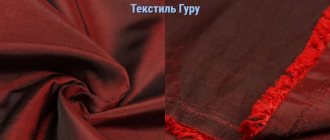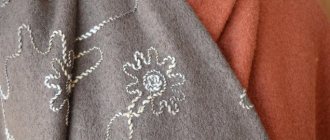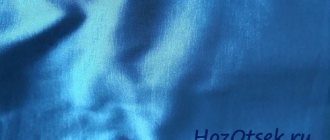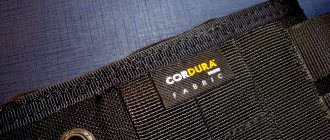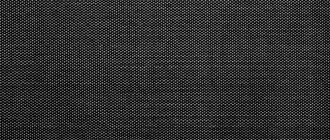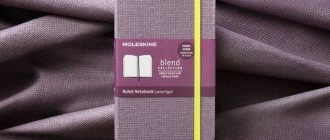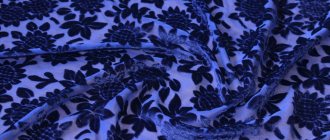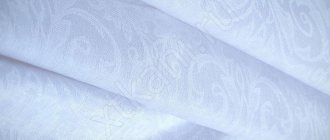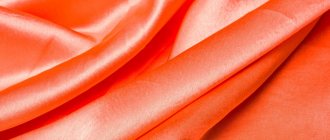Satori fabric was developed in Japan specifically for sewing workwear for medical workers. Today it is produced in some countries of Europe, the CIS and Russia. This is a unique material with all the necessary properties that make wearing such things comfortable and practical. In this article we explain in detail what satori fabric is, what it is made from and why it is popular in medicine.
Fabric Features
The main requirements for clothing in which medical workers actively work from morning to evening are convenience and safety. Next, we will discuss the characteristics of satori fabric, which accurately describe the properties and characteristics of matter.
- The plasticity of the fabric does not hinder movement.
- Durability and resistance to abrasion and wear.
- Does not become covered with pellets.
- The outer polyester layer of fabric repels any dirt and prevents infection.
- Sterilization of clothing in an autoclave is acceptable.
- With white items, you can safely use bleaching bleach.
- Colored fabrics retain their brightness for a long time even after numerous washes.
- Complies with GOST 9895-88, 24760-81 and EN13795-1-2011.
How to care for fabric
The material tolerates any washing modes, boiling, autoclaving, and bleaching. White uniforms can be washed at a temperature of 60-80 degrees, using chlorine-containing bleaches. Colored fabrics cannot be bleached.
If you dry the item after carefully straightening it, you don’t have to iron it afterwards. If there is a need for ironing, use a temperature range of 100-150 degrees. Steaming of items is allowed.
Store things folded or hung on hangers. White suits or gowns are placed in covers for long-term storage.
Composition and production
The composition of satori fabric is mixed and includes 50% cotton and 50% polyester. It is woven in such a way that the outer side is polyester and the inner side is cotton. The manufacturer took care of comfortable wear and pleasant sensations from things, and at the same time, the practicality of the front side. Thanks to the twill weave, satori is very durable, smooth and pleasant to the touch.
Satori is painted in a variety of colors. For doctors, these are usually white, light blue, turquoise and lilac. Children's doctors prefer uniforms with images of cartoon characters. Thermal printing designs can be easily applied to this fabric and the embroidery looks beautiful.
Features and characteristics of satori material, description of what it looks like
The supple twill weave gives satori an elegant look and a dramatic appearance. Therefore, this fabric has found its wide application in the manufacture of medical clothing, as well as for the manufacture of workwear for staff of hotels, restaurants, etc. At what temperature to wash cotton items and whether they shrink after washing, find out here.
The soft and pleasant material gently hugs the body, and the almost weightless lightness makes it convenient, comfortable and pleasant to wear satori workwear.
Composition: what is it made from?
Contains polyester and cotton in equal proportions. The natural base provides breathability, so wearing satori products is very practical. Very pleasant to the touch, gives a pleasant tactile sensation thanks to the cotton. Polyester prevents the product from losing its shape and increases the service life of the item. Read about curtains for the kitchen with a balcony door in this article.
The interlacing of threads deserves special attention - it consists of 2 layers. The inner part of the fabric is always made of cotton, while the outer part consists mostly of polyester. That is why on the front side it looks attractively shiny and very smooth to the touch.
Properties and quality
It has high qualities due to its unique composition. Main characteristics:
- light weight;
- crease resistance;
- plasticity and softness;
- hygroscopicity;
- practicality;
- slight shrinkage;
- wear resistance.
In addition to the listed qualities, it has antibacterial properties. Prevents the spread of pathogenic microorganisms on human skin, thereby preventing the occurrence of unpleasant odors. This property is very important for medical professionals.
Advantages and disadvantages
One of the advantages of the fabric is its composition. Since the front side is made of synthetic fiber, any stains can be removed from clothes without any problems. This is very practical, since gowns for medical workers must always be in presentable condition. Find out which foam rubber is best to use on a sofa at this link.
It is impossible not to mention one more advantage - the characteristics fully meet the requirements of GOSTs. Therefore, it is in demand in many organizations.
If we talk about the disadvantages, we can highlight the fact that satori is used exclusively for sewing workwear. If you use it for sewing clothes for every day, things will look unpresentable. And this is despite the fact that they are very practical in operation.
People in the medical profession cannot wear ordinary clothes at work, but work robes and suits must be very practical and comfortable.
Production
The composition was developed in Japan. Currently, this fabric is produced in a number of European countries, as well as in China and Russia. You can find a wide variety of types of fabric on sale. Their characteristics depend on the binding, density, and components of the material. This material will tell you about cushions for garden furniture.
Varieties of satori
Manufacturers produce satori fabric with different densities for different applications.
Software Soft fabric with a density of 130 g/m2, consisting of 60% cotton and 40% polyester.
Bamboo. Consisting of cotton and bamboo fibers. Density 145 g/m2.
Comfort. It is 100% cotton, very soft fabric with a weight of 165 g/2.
Light. The thinnest variety is satori light, with a density of 110 to 140 g/m2. Despite its thinness, the fabric is still very durable and wear-resistant.
Satori Satin. The densest satori fabric with a density of 190 g/m2. It has a satin weave, smooth and shiny surface. Consists of cotton and polyester in equal proportions.
Light stretch. Fabric with increased elasticity of fibers, thin and light.
Extrastretch. New generation fabric. It has high elasticity, does not deform in areas of greater stretch, fits tightly to the figure and does not hinder movement. Made from 60% cotton, 35% polyester and 5% lycra.
Properties
Thanks to the combination of natural, environmentally friendly cotton fiber with practical synthetics and a special method of weaving threads, the fabric has very good performance qualities:
- ease;
- softness and plasticity. Draps well and does not restrict movement;
- hygroscopicity. Quickly absorbs moisture and dries;
- color fastness and variety of colors;
- pleasant to the body. Due to the fact that one of the sides is completely natural, it does not cause irritation even with prolonged contact with human skin;
- practicality. The surface does not immediately absorb dirt and liquid; it can be removed with a cloth and it will remain clean;
- crease resistance. Practically does not wrinkle during use, even after washing when drying in a straightened state, it does not require ironing, but can be ironed if necessary;
- low percentage of shrinkage. At the production stage, the fabric undergoes a process of forced shrinkage and subsequently in the finished product will not lose its original shape or change size;
- wear resistance. It is resistant to abrasion, can withstand a large number of washes, boiling, steaming, bleaching and does not lose its basic properties and attractive appearance.
This is interesting: Moleskin fabric: special characteristics, brands, variety of applications
Application
What is sewn from satori besides medical uniforms? Uniforms for catering workers, hotels, cosmetologists, beauty industry workers (hairdresser, manicurist, tattoo, spa, massage). Clothing made from satori material not only provides comfort during long-term wear, but also protects against unwanted influences (contact with cream, penetration of other people's hair under clothing, blood, hair dye).
It is very important for service personnel in restaurants and cafes to look presentable and neat. Stylish aprons, shirts, skirts for waiters, chef's coats and caps are made from satori fabric.
Although this is rare these days, you can still find a kindergarten teacher and nanny in a beautiful white robe. Such clothing helps to comply with all sanitary standards and protects clothing from accidental contamination.
Cleaning companies that are popular today also use workwear made from satori fabric; in addition, they often decorate their uniforms with emblems or embroidery, which makes their company recognizable and popular.
Scope of application: what is sewn from fabric
Due to its high quality characteristics and practicality, the fabric has found wide application for sewing clothing for medical workers. In addition, workwear is made from satori for workers in beauty salons, cleaning companies, and catering companies. Find out how to starch fabric at home here.
Suits, robes, and hats are made from satori.
The workwear is highly resistant to a wide variety of stains, stains are easily removed from it, and can easily be washed in hot water.
Thanks to the large number of varieties of this fabric, its scope of application is constantly expanding.
Care
Satori fabric is easy to care for. If necessary, it can withstand sterilization in an autoclave and washing at high temperatures.
If your satori items do not need intensive processing, then you can get by with a regular short cycle wash at 40 degrees. All stains can be easily washed off using any washing gel. To preserve brightness, it is recommended to wash colored items in water no hotter than 40 degrees. You can spin satori at any speed. Iron with caution, preferably with a damp iron.
Recommendations for caring for fiber products
To ensure that things do not lose their appearance, have a neat appearance and last a long time, you must follow simple recommendations for proper care.
- Items should not be washed at temperatures above 60 °C. If clothes have additional color elements, the washing water temperature should not exceed 40 °C.
- Workwear should be bleached with extreme caution: if there are colored inserts, you should avoid getting chlorine-containing products on these areas. Otherwise, the product will lose its original appearance.
- After washing using aggressive detergents, the item should be rinsed well in water.
Ironing temperature should be no more than 150 °C.
The main advantages include the fact that with proper care, satori, chenille and even felt will not lose their appearance even after prolonged wear.
Reviews
Reviews of satori fabric are left by both medical workers and seamstresses who directly work with this fabric.
Inga: “At our garment factory we sew uniforms for doctors at a children’s hospital. Satori fabric for such things is the best, and not only for doctors, but also for me as a seamstress. It’s easy to work with such material: it almost doesn’t slip and doesn’t crumble when cut, doesn’t shrink during steam processing, and simply fits beautifully to any figure.”
Valery: “As a senior waiter at a large restaurant, I can responsibly declare: uniforms made from satori are the best at removing stains of any complexity. Our aprons and shirts often get dirty with fatty sauces and bright wines, and all this can be washed well with any powder.”
Katya: “I am a dentist by profession, and while working, tooth chips, particles of medicine, and sometimes even blood often get on my clothes. Therefore, it is very important to have a well-protective uniform for such work. And there is such a thing - clothes made from satori material. It does not allow even the smallest particles to pass through and is easily washed off from dirt.”
Advantages and disadvantages
Satori is a practical and comfortable material that, if handled correctly and carefully, will last for many years. However, its density and specific performance properties do not allow the unique fabric to be used for sewing other types of clothing, except for work uniforms, since things of a different cut in this case look shapeless and too bulky.
Pros:
- durability;
- resistance to wear and high temperatures;
- density;
- elasticity;
- dimensional stability;
- matter is little polluted;
- ease of care.
Minuses:
- difficulty in working with fabric;
- the inability to use fabric for sewing other types of products, except for workwear.
A work uniform made from this fabric always looks very neat. The canvas can be starched and bleached, so the snow-white shade is easily maintained.
The fabric is easily smoothed after washing and does not require the use of special detergents.
Advantages and disadvantages
The main advantage of satori fabric is its composition. Since the upper part of the fabric is made of polyester, stains can be easily removed after one wash using a chemical such as bleach. This is convenient and practical, because specialized suits are issued to employees in limited quantities and their condition must be constantly monitored.
Another plus is that the fabric characteristics comply with medical standards and GOSTs. Satori is popular in various cleaning companies, catering establishments, and beauty salons.
To ensure that a satori product always has a neat appearance, experts recommend adhering to the following rules.
- The maximum washing temperature should not exceed 60 °C. If there are colored inserts, washing at a temperature of 40 °C is allowed.
- When bleaching, it is important not to touch parts that have a color other than white, otherwise they will lose their external characteristics.
- After the product has been removed from dirt, it is recommended to rinse it additionally in clean water.
- The optimal temperature for ironing is 150 °C.
Another advantage is that the fabric will not quickly lose its properties after numerous washes. Sometimes logos of institutions and companies are applied to the material. You need to be careful here, as they may lose their properties when washed. This is the main drawback of the fabric, since when ironed, the brand marks will lose their attractive appearance.
Another disadvantage is the fact that satori is used only for sewing specialized clothing. When sewing products for everyday wear, things will look shapeless and “official”, despite the fact that they are quite practical in use.
